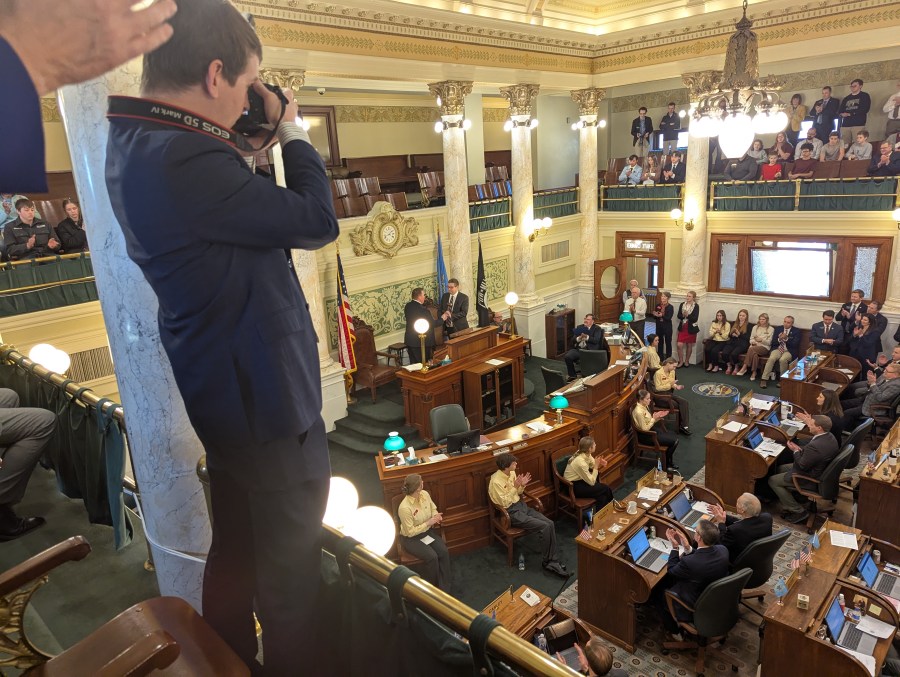PIERRE, S.D. (KELO) — Something rare is taking place at the South Dakota Capitol this week, as a new governor, Larry Rhoden, and a new lieutenant governor, Tony Venhuizen, take office, amid some unusual circumstances.
This passage of power came not only in the middle of a governor’s term, but with the Legislature already two weeks into its annual session.
Out went an administration that had run on openness but had become increasingly secretive and too often focused too much on Washington, D.C., politics.
In came a new administration, with some different people in key posts, bringing a new message of civility and transparency.
This transition, replacing silence with responsiveness, began to emerge on a Friday a week ago.
That afternoon, Rhoden was still serving as South Dakota’s lieutenant governor, presiding as Senate president. Many in the chamber however sensed or knew it likely would be his final time.
Three of Rhoden’s grandchildren joined him up at the rostrum, climbing around on the chairs, while senators down on the Senate floor gave impromptu speeches praising the lieutenant governor. They spoke about how well he had run the chamber the past six years. He in turn was telling them that it’s the people you remember, not the votes or bill numbers.
SD Democrats show frustration over ‘imported ideas’
This was because the sitting governor, Kristi Noem, was expected to be confirmed at some point during the weekend by the U.S. Senate as the nation’s new secretary of homeland secretary. Her pending confirmation meant Noem soon would be departing state government’s highest elected office two years early, smack in the middle of the second four-year term that the voters in 2022 had elected her to serve.
Noem’s official letter of resignation on Saturday came shortly after the U.S. Senate voted to confirm her federal appointment. Her letter immediately triggered the succession provision in the South Dakota Constitution that says, “When the office of Governor shall become vacant through death, resignation, failure to qualify, conviction after impeachment or permanent disability of the Governor, the lieutenant governor shall succeed to the office and powers of the Governor.”
Larry Rhoden no longer was lieutenant governor. He was now Governor Larry Rhoden. He was getting ready to haul a load of steel to Cammack Ranch Supply in the small community of Union Center out in Meade County when he heard the news.
Rhoden and Noem spoke briefly in a phone call.
They had spent months preparing for this day.
Noem would be moving back to Washington, D.C., a 22-hour drive by highway.
Rhoden would be moving to the Governor’s Mansion. He made the two-hour trip back to Pierre as the same man physically, but with all of the responsibilities of governor suddenly on his shoulders.
At the Capitol on Monday morning, during a ceremony in the Governor’s Office, Rhoden officially took the oath from South Dakota Supreme Court Chief Justice Steven Jensen.
Then Rhoden briefly took questions from the news reporters. The first: Who would Rhoden nominate as the next lieutenant governor? Rhoden said the announcement would come later in the week.
On that same day, Rhoden spoke privately with a member of the South Dakota Legislature, Rep. Tony Venhuizen, about becoming South Dakota’s next lieutenant governor. Venhuizen said yes. They agreed that any word about the decision should be held as close as possible for as long as possible.
On Tuesday afternoon, Rhoden delivered his first speech as governor to a joint assembly of the Legislature. He introduced his wife, First Lady Sandy Rhoden, and others in his family. He also gave lawmakers some insight into how he reaches decisions, thinking through difficult issues while using his hands to make a livestock branding iron or a ranch tool.
Rhoden told legislators that civility would be important in his new administration. At the same time, he laid out a conservative, pro-Trump Republican vision for how he intends to lead South Dakota.
Some lawmakers thought Rhoden would publicly announce his choice for lieutenant governor during the speech, but he told them that would be come later in the week. A good-natured groan rose from the 100-some representatives and senators crammed into the 70-desk House chamber.
By Wednesday morning, the Capitol rumor mill was thick with one name: Tony Venhuizen. Gov. Rhoden held a news conference at 10 a.m. to announce his choice for lieutenant governor.
Rhoden came into the room alone. After describing what he was looking for in the next lieutenant governor, Venhuizen opened the door and walked in. The two men shook hands, their smiles wide as cameras recorded the moment.
Venhuizen spoke about how the lieutenant governor must be a partner to the governor. Among his comments was a double-dose of news: He had submitted a letter that morning resigning from his seat in the state House of Representatives; and, if confirmed by the Legislature, he would serve at Rhoden’s request as a full-time lieutenant governor.
Venhuizen resigned because a provision in the South Dakota Constitution says legislators are ineligible for other offices.
It states, “No member of the Legislature shall, during the term for which he was elected, be appointed or elected to any civil office in the state which shall have been created, or the emoluments of which shall have been increased during the term for which he was elected, nor shall any member receive any civil appointment from the Governor, the Governor and senate, or from the Legislature during the term for which he shall have been elected, and all such appointments and all votes given for any such members for any such office or appointment shall be void.”
Venhuizen’s decision to resign before knowing whether he would be confirmed reflected his respect for the state constitution. But it was also because it was the right thing to do.
The transition of power from Noem to Rhoden marked only the third time that a South Dakota governor hadn’t completed his or her elected term.
The first came in 1978, when Democratic Gov. Dick Kneip resigned that July to accept a federal appointment as the U.S. ambassador to Singapore. His lieutenant governor, Harvey Wollman, succeeded Kneip as governor, but with only months left in the Kneip-Wollman term, a new lieutenant governor wasn’t chosen.
The second time that a governor didn’t finish his term came about because of one of the most tragic accidents in the state government’s history.
Gov. George S. Mickelson and seven other men aboard the state airplane died in a crash on April 19, 1993. His lieutenant governor, Walter Dale Miller, succeeded Mickelson as governor. Governor Miller nominated Steve Kirby as lieutenant governor and Kirby was confirmed.
Miller ran for election to a term of his own but lost to Bill Janklow in the 1994 Republican primary. Janklow, who had served as governor the two terms before Mickelson, went on to win two more terms as governor.
The division from the Miller-Janklow battle, as well as Janklow’s unsuccessful but damaging challenge to Republican U.S. Jim Abdnor eight years earlier, was not lost on anyone active in South Dakota politics during the 1980s and ’90s.
There are parallels between Miller and Rhoden. Both grew up on ranches in Meade County. Miller was 67 years old when he became governor, the oldest in South Dakota history; Rhoden at age 65 is now the state’s second-oldest governor.
Then there’s their legislative experience. Miller had served 20 years in the state House when Mickelson picked him as running mate in 1986. Rhoden had 16 years of legislative experience in the House and the Senate when Noem chose him in 2018.
Rhoden, during the Wednesday morning announcement of Venhuizen, stepped around a reporter’s attempt to pin down what the selection of Venhuizen might signal about whether Rhoden planned to run for election in 2026 for a term of his own as governor.
But on Wednesday afternoon, during his first formal interview as governor in his second-floor Capitol office, Rhoden gave a deeper answer.
He told two KELOLAND News reporters that he wanted to first focus on the 2025 legislative session and then, in the spring, decide whether he would be a candidate next year.
Later that afternoon, Rhoden went up to the fourth floor of the Capitol and made his pitch on behalf of Venhuizen to the Senate Select Committee on the Nomination for Lieutenant Governor.
The South Dakota Constitution lays out the powers and duties of the lieutenant governor. That provision says, “The lieutenant governor shall be president of the senate but shall have no vote unless the senators be equally divided. The lieutenant governor shall perform the duties and exercise the powers that may be delegated to him by the Governor.”
Rhoden told the five senators that he went through an extensive selection process and why Venhuizen was his choice. The committee next took public testimony. One of the people speaking in support of Venhuizen was his father in law, former Governor Dennis Daugaard.
Venhuizen worked eight years on Daugaard’s senior staff, as communications director during the first term, and chief of staff during the second term.
Venhuizen also served as chief of staff for Noem for a period of about 14 months, before she appointed him to the state Board of Regents in 2021. Venhuizen resigned from the regents in January 2022, when he officially became a candidate for the House.
When Venhuizen’s time came to address the committee, he introduced his wife, Sara, and their three children, who were all in the room.
Then he gave his priorities for state government, saying he wanted to maintain South Dakota as “a cautious, conservatively run state,” and answered questions from the senators, such as what he expected his duties to be and where he would perform them.
Venhuizen said he planned to work from the lieutenant governor’s office in the Capitol during the winter legislative session and, during the other nine months, split time between Pierre and Sioux Falls.
The five senators unanimously recommended his confirmation. That was important.
The South Dakota Constitution says candidates for governor and lieutenant governor run as a team and shall be elected jointly. Noem and Rhoden, for example, had run together twice, in 2018 and 2022, and each time they were elected to a four-year term.
But Rhoden and Venhuizen weren’t running for election, at least not yet.
A sentence in the succession provision of the South Dakota Constitution specifically says what is to happen when the lieutenant governor’s seat becomes empty.
It states, “Whenever there is a permanent vacancy in the office of the lieutenant governor, the Governor shall nominate a lieutenant governor who shall take office upon confirmation by a majority vote of all the members of each house of the Legislature.”
Those votes came Thursday.
35-0 in the Senate.
67-0 in the House.
The Senate president pro tem, Republican Chris Karr, had been presiding in the absence of a lieutenant governor. To mark Venhuizen’s confirmation, Karr presented a gavel to him
“It is a great day for South Dakota,” Karr told Venhuizen, “and I look forward to working with you in the Senate and the executive branch.”







